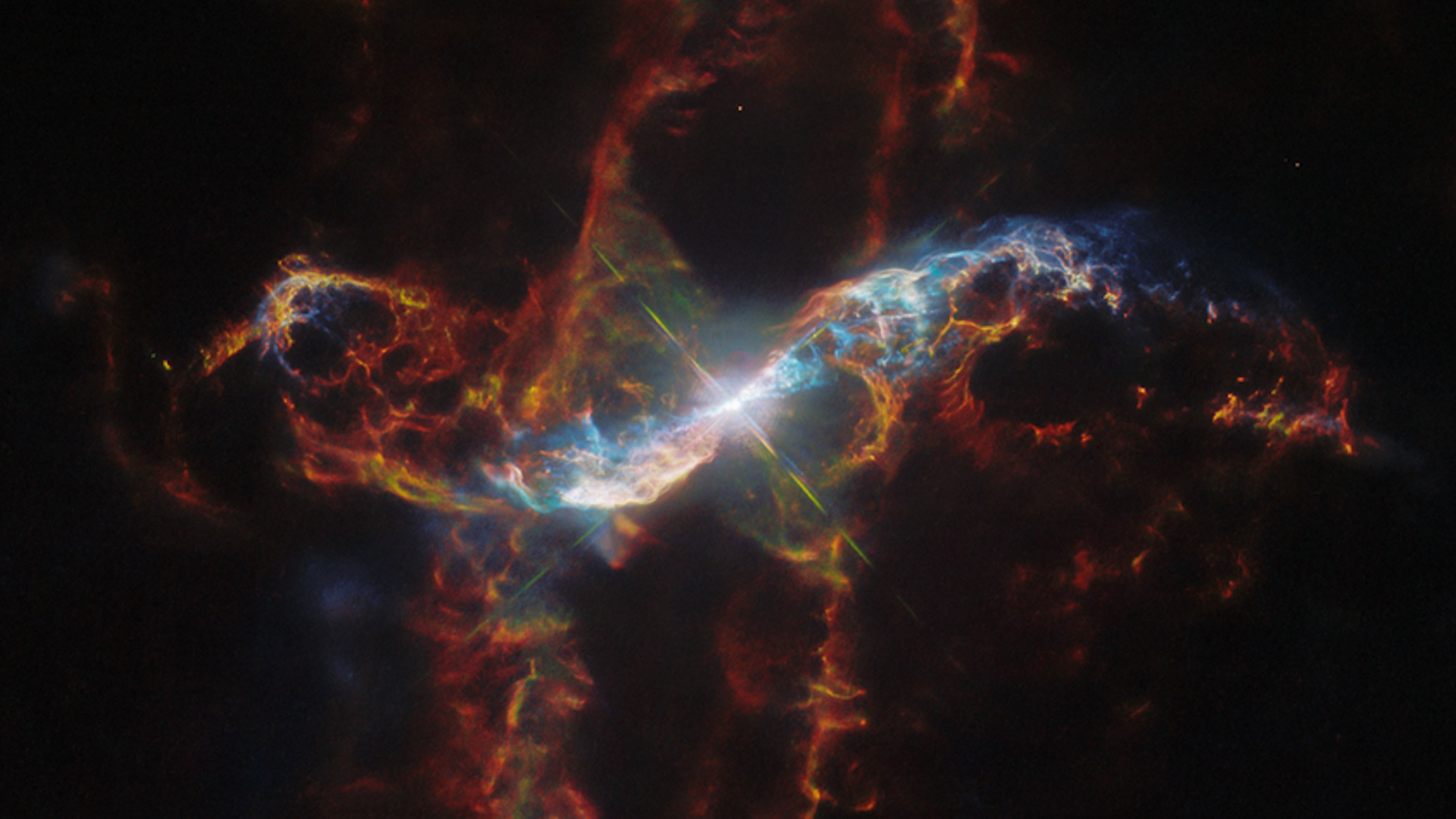Hubble Telescope sees 'stellar volcano' erupt in amazing colors (video, photo)
The nebula, R Aquarii, looks like 'a lawn sprinkler gone berserk.'
The Hubble Space Telescope has captured an intricate portrait of two nearby stars that have been in close contact for centuries, revealing once again the complex yet volatile relationship of a stellar duo.
The striking, hour-glass-shaped nebula seen in the new image was forged from the centuries-long interaction between its two distinct occupants: a compact, largely unchanging white dwarf and its companion star, an aging red giant that has swelled to more than 400 times our sun's size and dims and brightens over a fairly long period of 387 Earth days.
The star system, known as R Aquarii, resides about 710 light-years from Earth in the constellation Aquarius. It belongs to the symbiotic class of variable stars, a classification borrowed from the biological term "symbiosis," which refers to two organisms of different species coexisting close to one another.

Indeed, the white dwarf swings close to the red giant during its 44-year orbit, funneling material onto its surface, occasionally exploding like "a gigantic hydrogen bomb," the Hubble team said in a recent statement.
Related: The best Hubble Space Telescope images of all time!
The outburst blasts into space twisted, geyser-like streamers of glowing gas that make the region look like "a lawn sprinkler gone berserk," the statement read. The ejected material shoots into space at over 1 million mph (1.6 million kph), which is "fast enough to travel from Earth to the moon in 15 minutes!"
"This dramatically demonstrates how the universe redistributes the products of nuclear energy that form deep inside stars and jet back into space," the statement added. Some of those products include heavier elements like carbon, nitrogen and oxygen, all of which are crucial building blocks of planets like our own and life as we know it.
Get the Space.com Newsletter
Breaking space news, the latest updates on rocket launches, skywatching events and more!
Being one of the nearest symbiotic stars, R Aquarii is well-studied by multiple space- and ground-based telescopes. The Hubble telescope itself started observing it soon after launching into orbit in 1990. A decade later, the Chandra X-ray observatory began monitoring changes in X-ray emission from the nebula, chiefly those radiated by its knotted jet and the shockwaves it generated upon striking surrounding material. Based on these observations, astronomers suspect the white dwarf may have last erupted in the late 1970s, suggesting the next explosion may occur no sooner than the 2470s.
Hubble's latest close-up of the star system shows the ejected material to have weaved into a spiral pattern — a result of being twisted by the sheer force of the explosion and then twisted while being pushed outward by powerful magnetic fields.
Scientists also stitched five Hubble images of R Aquarii from the past decade into a timelapse video that highlights the dips in brightness of the stellar duo, caused by strong pulsations of the red giant, as well as the dramatic evolution of the surrounding nebula.
Using such images, astronomers have traced out the emitted material to at least 248 billion miles (400 billion kilometers) from the star, or 24 times our solar system's diameter, which is "extraordinary even in astronomical terms," the Hubble team noted.
Join our Space Forums to keep talking space on the latest missions, night sky and more! And if you have a news tip, correction or comment, let us know at: community@space.com.

Sharmila Kuthunur is a Seattle-based science journalist focusing on astronomy and space exploration. Her work has also appeared in Scientific American, Astronomy and Live Science, among other publications. She has earned a master's degree in journalism from Northeastern University in Boston. Follow her on BlueSky @skuthunur.bsky.social









